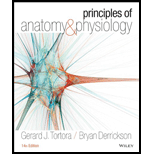
Principles of Anatomy and Physiology
14th Edition
ISBN: 9781118345009
Author: Gerard J. Tortora
Publisher: WILEY
expand_more
expand_more
format_list_bulleted
Question
Chapter 24, Problem 40CP
Summary Introduction
To review:
The difference between the muscularis found in the large intestine and remaining GI (gastrointestinal) tract. Also, describe haustra.
Introduction:
The end or terminal region of GI tract is the large intestine. Its main function is to complete the absorption of nutrients from the digested food particle. It is also involved in feces formation and its expulsion from the body.
Expert Solution & Answer
Want to see the full answer?
Check out a sample textbook solution
Students have asked these similar questions
please draw in what the steps are given.
Thank you!
please draw in and fill out the empty slots from image below.
thank you!
There is a species of eagle, which lives in a tropical forest in Brazil. The alula pattern of its wings is determined by a single autosomal gene with four alleles that exhibit an unknown hierarchy of dominance. Genetic testing shows that individuals 1-1, 11-4, 11-7, III-1, and III-4 are each homozygous.
How many possible genotypes among checkered eagles in the population?
Chapter 24 Solutions
Principles of Anatomy and Physiology
Ch. 24 - Which components of the digestive system are GI...Ch. 24 - 2. Which organs of the digestive system come in...Ch. 24 - Which kinds of food molecules undergo chemical...Ch. 24 - Prob. 4CPCh. 24 - 5. Name the four layers of the gastrointestinal...Ch. 24 - Prob. 6CPCh. 24 - Prob. 7CPCh. 24 - Prob. 8CPCh. 24 - Prob. 9CPCh. 24 - Prob. 10CP
Ch. 24 - How are the major salivary glands distinguished on...Ch. 24 - Prob. 12CPCh. 24 - What functions do incisors, cuspids, premolars,...Ch. 24 - To which two organ systems does the pharynx...Ch. 24 - Prob. 15CPCh. 24 - Prob. 16CPCh. 24 - Prob. 17CPCh. 24 - Prob. 18CPCh. 24 - Prob. 19CPCh. 24 - 20. Compare the epithelium of the esophagus with...Ch. 24 - Prob. 21CPCh. 24 - Prob. 22CPCh. 24 - What are the functions of gastric lipase and...Ch. 24 - Prob. 24CPCh. 24 - Prob. 25CPCh. 24 - Prob. 26CPCh. 24 - Prob. 27CPCh. 24 - Prob. 28CPCh. 24 - Prob. 29CPCh. 24 - Prob. 30CPCh. 24 - Describe the major functions of the liver and...Ch. 24 - 32. List the regions of the small intestine and...Ch. 24 - Prob. 33CPCh. 24 - Describe the types of movement that occur in the...Ch. 24 - Prob. 35CPCh. 24 - What is the difference between digestion and...Ch. 24 - By what routes do absorbed nutrients reach the...Ch. 24 - 38. Describe the absorption of electrolytes,...Ch. 24 - What are the major regions of the large intestine?Ch. 24 - Prob. 40CPCh. 24 - 41. Describe the mechanical movements that occur...Ch. 24 - What is defecation, and how does it occur?Ch. 24 - Prob. 43CPCh. 24 - What is the purpose of the cephalic phase of...Ch. 24 - Prob. 45CPCh. 24 - 46. Outline the steps of the enterogastric...Ch. 24 - Prob. 47CPCh. 24 - Prob. 48CPCh. 24 - 49. What are the general effects of aging on the...
Knowledge Booster
Similar questions
- students in a science class investiged the conditions under which corn seeds would germinate most successfully. BAsed on the results which of these factors appears most important for successful corn seed germination.arrow_forwardI want to write the given physician orders in the kardex formarrow_forwardAmino Acid Coclow TABle 3' Gly Phe Leu (G) (F) (L) 3- Val (V) Arg (R) Ser (S) Ala (A) Lys (K) CAG G Glu Asp (E) (D) Ser (S) CCCAGUCAGUCAGUCAG 0204 C U A G C Asn (N) G 4 A AGU C GU (5) AC C UGA A G5 C CUGACUGACUGACUGAC Thr (T) Met (M) lle £€ (1) U 4 G Tyr Σε (Y) U Cys (C) C A G Trp (W) 3' U C A Leu בוט His Pro (P) ££ (H) Gin (Q) Arg 흐름 (R) (L) Start Stop 8. Transcription and Translation Practice: (Video 10-1 and 10-2) A. Below is the sense strand of a DNA gene. Using the sense strand, create the antisense DNA strand and label the 5' and 3' ends. B. Use the antisense strand that you create in part A as a template to create the mRNA transcript of the gene and label the 5' and 3' ends. C. Translate the mRNA you produced in part B into the polypeptide sequence making sure to follow all the rules of translation. 5'-AGCATGACTAATAGTTGTTGAGCTGTC-3' (sense strand) 4arrow_forward
- What is the structure and function of Eukaryotic cells, including their organelles? How are Eukaryotic cells different than Prokaryotic cells, in terms of evolution which form of the cell might have came first? How do Eukaryotic cells become malignant (cancerous)?arrow_forwardWhat are the roles of DNA and proteins inside of the cell? What are the building blocks or molecular components of the DNA and proteins? How are proteins produced within the cell? What connection is there between DNA, proteins, and the cell cycle? What is the relationship between DNA, proteins, and Cancer?arrow_forwardWhy cells go through various types of cell division and how eukaryotic cells control cell growth through the cell cycle control system?arrow_forward
arrow_back_ios
SEE MORE QUESTIONS
arrow_forward_ios
Recommended textbooks for you
 Human Physiology: From Cells to Systems (MindTap ...BiologyISBN:9781285866932Author:Lauralee SherwoodPublisher:Cengage Learning
Human Physiology: From Cells to Systems (MindTap ...BiologyISBN:9781285866932Author:Lauralee SherwoodPublisher:Cengage Learning Human Biology (MindTap Course List)BiologyISBN:9781305112100Author:Cecie Starr, Beverly McMillanPublisher:Cengage Learning
Human Biology (MindTap Course List)BiologyISBN:9781305112100Author:Cecie Starr, Beverly McMillanPublisher:Cengage Learning

Human Physiology: From Cells to Systems (MindTap ...
Biology
ISBN:9781285866932
Author:Lauralee Sherwood
Publisher:Cengage Learning

Human Biology (MindTap Course List)
Biology
ISBN:9781305112100
Author:Cecie Starr, Beverly McMillan
Publisher:Cengage Learning



